Updated on November 21, 2022
“B2B data is the pillar of outbound sales.”
In today’s world, information is gold.
CIA and FBI are excellent examples of the truth behind this statement. In order to be effective at their job, they’ll do anything in their power to collect accurate and reliable intel on their POI (Person of Interest).
Similarly in the business world, we need B2B data (business information) on our ICP (Ideal Customer Profile) to be effective at our job when performing sales and marketing activities.
What is B2B data?
B2B data is business information and intelligence about companies and contacts from a variety of industries and locations worldwide, crucial for sales teams and marketing leaders.
It is gathered from a variety of public and private sources and can be applied to many business tasks, including revenue operations and making data-driven business decisions.
In the B2B business model, our target prospects are other companies that fit all the criteria for becoming paying customers of our services. We call them target accounts.
But since we’re still selling to people, not companies, the B2B data does not only include vital company insights but also contact information of the professionals working inside those organizations.
This allows you not only to find your target companies but also to get a list of the entire buying committee in those accounts and contact them.
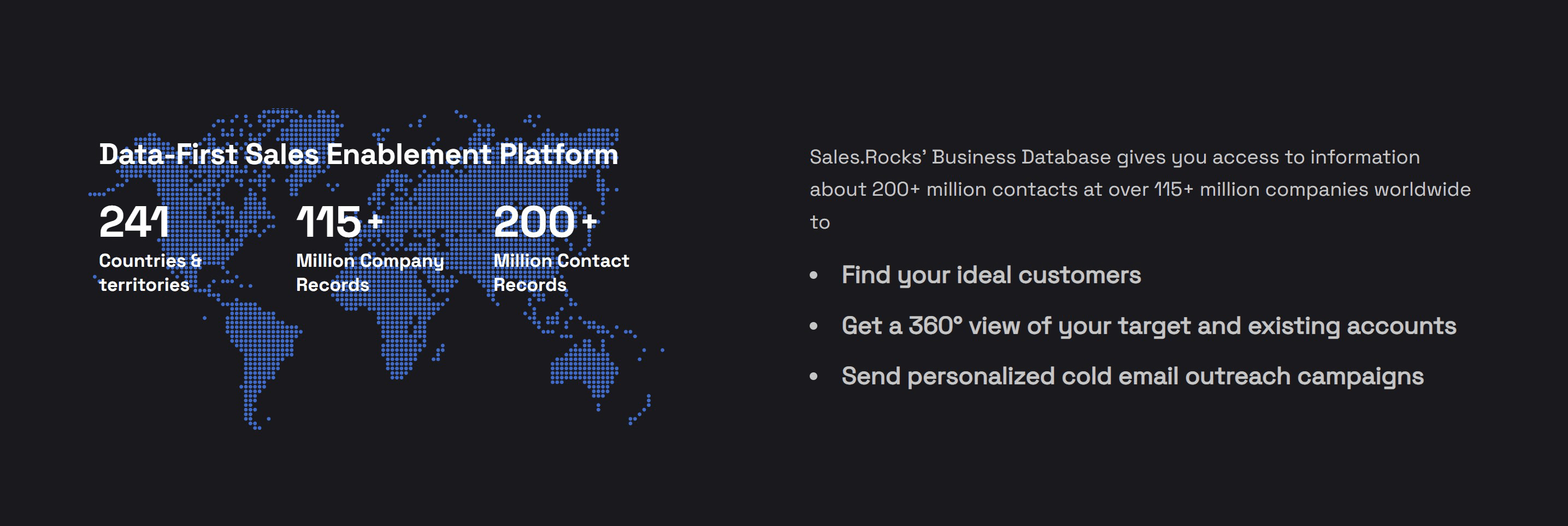
B2B data points on company level:
- Company name and legal form (registered ownership);
- Head Quarters + Subsidiaries: location per region/country/city (for geophysical prospecting);
- Street Address (street name and number);
- URL – Company website domain;
- Company’s email address and phone number;
- Operating status – Is the company still active on the market or not?;
- Turnover – Company revenue in a particular period;
- Company Size (Employee Range + Revenue Range);
- Employee range -Total number of employees at company + Organizational tree by Hierarchy;
- Technographics – Technology and applications that are used on the company website (e.g. program languages, web frameworks, payment gateways, operating systems, etc.);
- Monthly Tech Spending.
B2B data points on contact level:
- Name and surname;
- Job title and department;
- Job position in the Organizational Tree by Hierarchy (Director, Executive, Manager…);
- Current location – country & city;
- Direct email address and phone number;
- Personal LinkedIn profile.
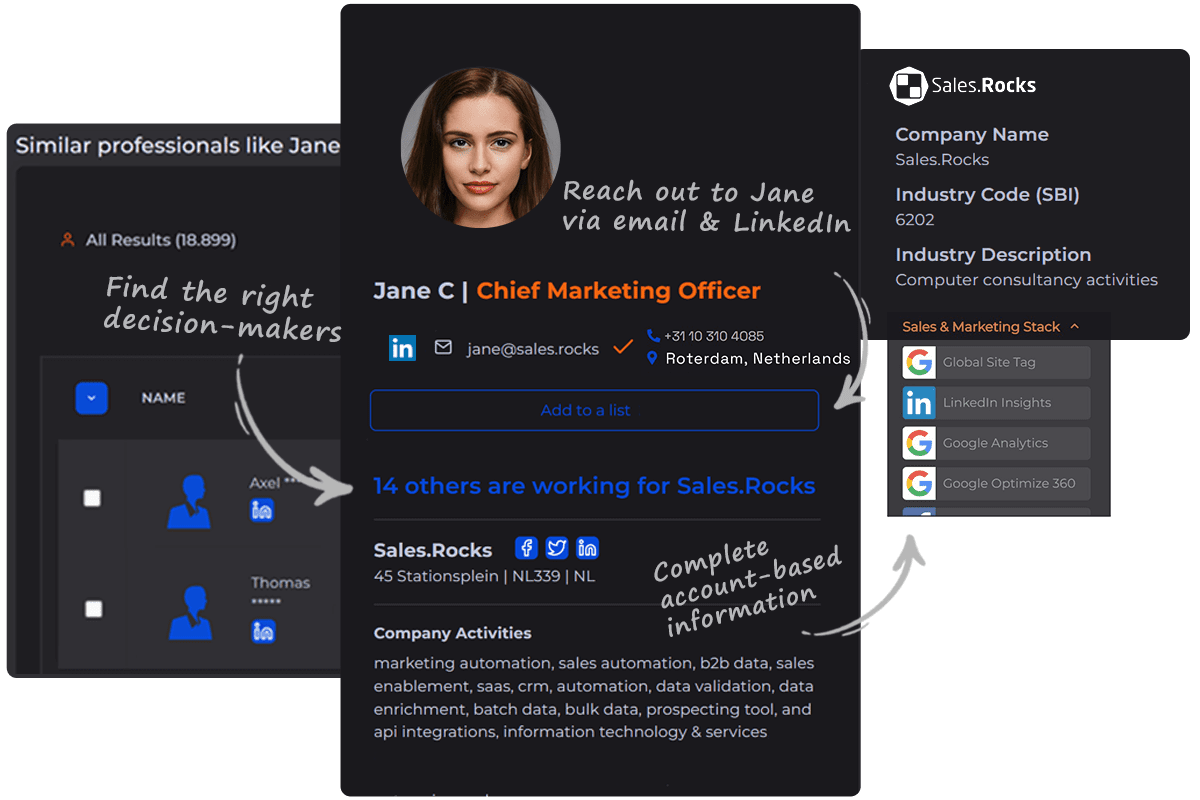
B2B data collection
The B2B data is usually collected through a variety of private and public (open data) sources.
Public sources:
- Company registers and business directories;
- Website and social media profiles;
- News articles and search engine results;
Private sources:
- Paywall providers;
- Financial and market intelligence;
- Data as a Service (DaaS) providers.
And then it is stored in a huge B2B database. B2B database is a digital library filled with company profiles and business contacts from which you can search, filter, and narrow down the perfect-match companies for your product or service.
Sales organizations rely on accurate B2B data to get the contact info of the decision-makers working there.
Types of B2B Data
There are many different types of B2B data, but the most common ones are:
Demographic data
Demographics are the hard facts about your target audience, such as:
- age
- gender
- nationality
- current location in Region/Country/City
- skills/education
- ethnicity
- generation, etc.
This data pertains to their social aspect and relative position within their culture. It’s not particularly personal, but it gets you started on understanding your buyer intent.
These characteristics can be based on their persona or geography and can help you change your offering or spot trends in how different people are responding to your campaigns.
Firmographic data
Firmographic data includes industry, company size, and revenue information that help you place each target account into an appropriate business context and construct meaningful customer profiles (firmographic segments).
You can then place each prospecting company into a specific segment according to their mutual characteristics & pain points related to your products/services.
e.g. a segment can be created to target companies in the Manufacturing industry, with 50-200 employee count, and $100,000+ p/m revenue.
Some of the key attributes of firmographic data include:
- Company’s legal status (publicly owned, privately owned, non-profit, NGO, Inc., LLC.)
- Company’s offices location (region, country, state, city, zip code, address)
- Company’s industry (SIC classification codes)
- Company size (including revenue, number of employees, SME)
- Performance (sales cycle length, sales numbers, quarterly and annual profits, credit rating)
- Company structure (headquarters, parent companies, subsidiaries)
Related read Firmographic Segmentation: Nail down your Ideal Customer Profile in B2B
Technographic data
Technographic data refers to the information about a company’s technology solutions in use. In other words, technographics help you with profiling target companies based on their tech stack:
- Software apps
- Digital tools
- Platforms
- Plugins and extensions
- Hosting providers, etc.
With the rapidly increasing number of tech solutions available on the market and adopted by companies, understanding what technologies your prospects are using can enable you to personalize your proposal in a way that is meaningful for them.
This is especially useful for technology providers since technographic data helps identify which companies are best to target depending on whether they already use a tool that can be integrated with your solution.
Knowing key insights such as if they recently purchased a new CRM, are using a competitor’s product or service, or if they are using an outdated automation tool can help deliver the right message to the right account.
Here are the core data attributes for technographic data:
- The technologies being used
CMS (WordPress), CRM (HubSpot), Cold Email Outreach Software (Sales.Rocks), etc. - How does the organization is using these technologies?
- What is their monthly tech spend?
A company’s technology stack offers a unique look into the organization. It can reveal exactly what the organization is willing to spend money on, their level of technical know-how, and whether they will benefit from your SaaS solution.
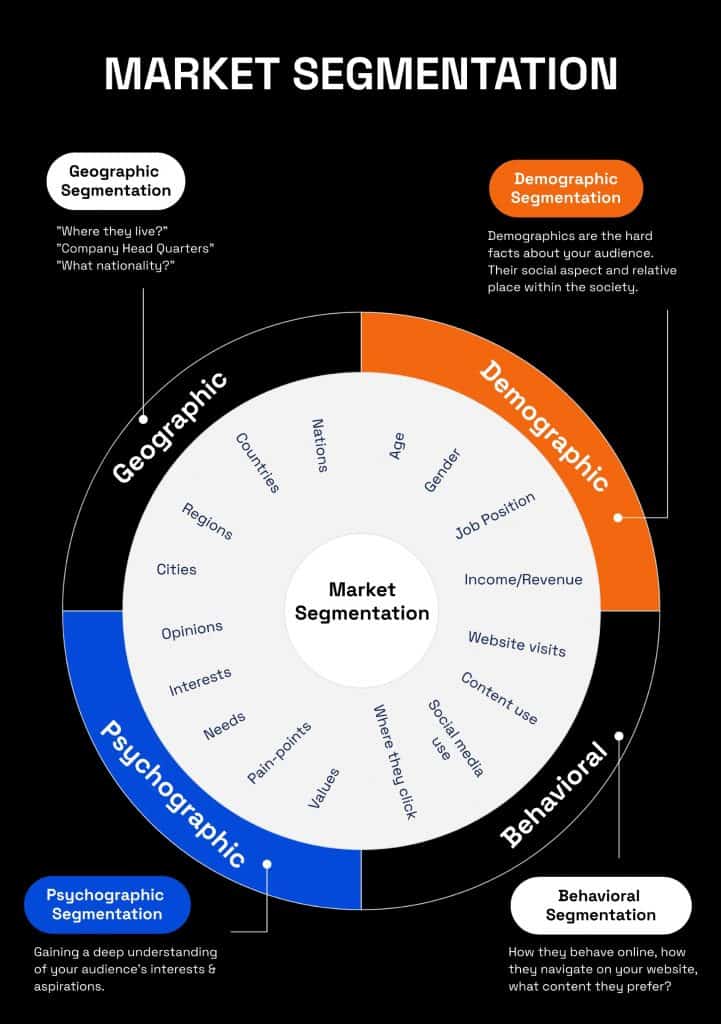
What is B2B data used for?
Everything starts with data. B2B data is mainly used by sales reps and marketing professionals in business-to-business organizations to get a 360° view of their target audience and thus be able to perform:
- TAM Identification
- Automated sales prospecting;
- ICP development & Firmographic segmentation;
- Account-based marketing;
- Advanced email personalization;
- Outbound sales / cold outreach;
Here is what you can do with B2B data as part of your sales and marketing activities:
TAM Identification
B2B data is crucial for defining your Total Addressable Market (TAM) – the total number of potential prospects in your target market and all of the selling opportunities for your organization. It is a monetary value that represents the overall revenue opportunity that is available to a product or service if 100% market share was achieved.
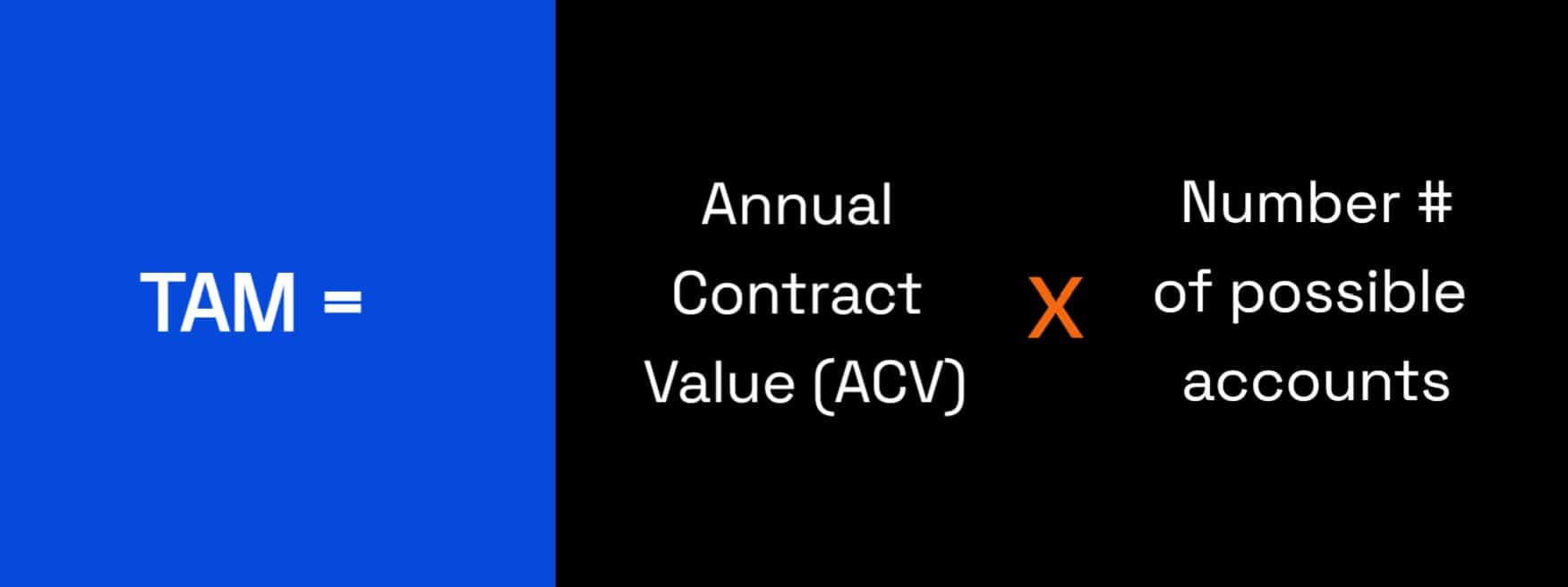
TAM is one of the essential metrics that startups and SMBs use to estimate the potential scale of the market, especially when releasing a new product, targeting a new customer segment, or planning to upsell & cross-sell to existing customers.
Without access to B2B data for your target market, you won’t be able to understand your market share—how big is it?; the industry coverage, cost evaluation, and who are the decision-makers in your target companies from a certain location, industry, and niche.
In other words, without it, you’re severely cut off from crucial business information that will help you sell your services and understand where your business currently stands among competitors and where it can grow in the future.
Though TAM can be calculated with a simple formula, to be able to use the formula you’ll need accurate company data and market research. And the quality, scope, and accuracy of your company and B2B contact data make all the difference.
Automated Sales Prospecting
Automated prospecting is identifying your ideal customers, sourcing their contact details, and reaching out to them, all in the same sequence and from the same platform.
B2B databases usually have filtering systems that enable you to filter through various B2B data points and discover and identify the highest-value prospects for your products and services. Then you can add them to a lead list and push them straight into a new campaign —prospecting automation in practice.
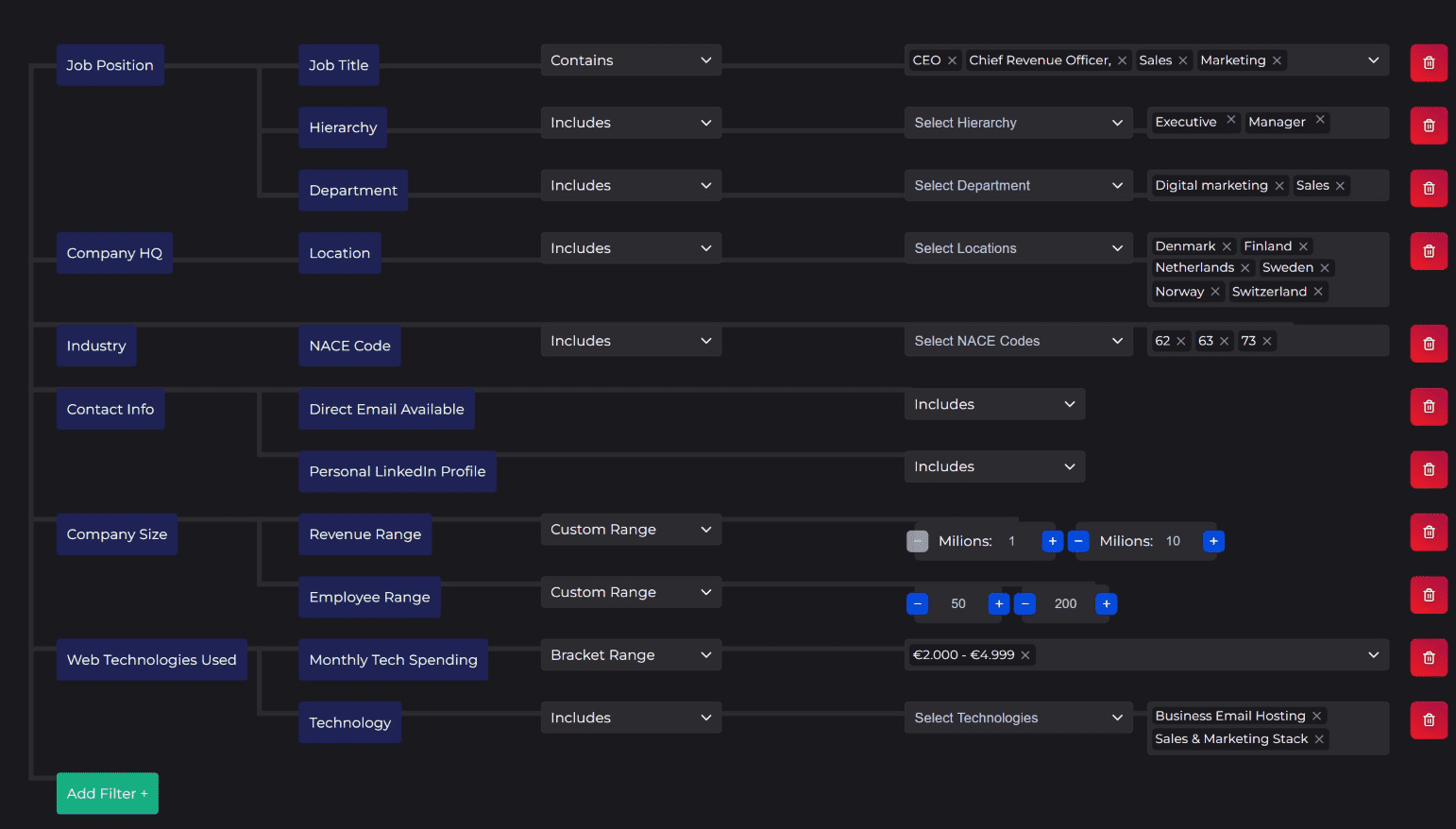
Any business will benefit from access to a B2B data provider because it reduces the time and effort it takes to track down the contact information of your potential customers, which otherwise needs to be done manually by SDRs.
You can buy B2B contact lists from third-party data providers and then send cold email campaigns from different software (e.g. for cold outreach). However, companies that use one centralized platform for their sales activities report smoother business interaction and enjoy prospecting on automation without obstacles along the way.
ICP Development & Segmentation
Use the intent data you already have on your existing customers to understand who might fit your ideal customer profile.
Then you will have an understanding of the main attributes you need to look for in your pool of prospects and qualify the most appropriate candidates for becoming your future customers.
When you have identified the ideal buyers and compiled a list of them with the necessary data on each account, you can divide them into different customer segments according to their shared characteristics (e.g. group them by their job title or the technology they’re using).
Then you can create one email template for each segment, that will speak specifically to the interests of that group of people you’re trying to establish a connection with.
Advanced Email Personalization
The template will be addressed to the segment, but each recipient on your email list will see its own name, their company’s logo, or a personalized email opener that speaks only to them, using merge tags.
This way you will be reaching out to 30, 50, or 80 people at the same time on automation, but even so – each one of them will receive a message that resonates with them.
Outbound Sales / Cold Outreach
The outbound sales process consists of a sales rep trying to establish a connection with prospects using phone, email, social selling, or networking for the first time.
The most popular outbound sales techniques are cold calling and cold emailing. And they cannot be done without access to B2B data — such as prospects’ email addresses and phone numbers.
But being successful at cold outreach also requires leaving a good first impression. That’s where B2B data helps out the most, providing you with valuable insights to personalize your approach and provide meaningful context to your prospect for your cold email or phone call.
Account-based Marketing
The idea behind account-based marketing (ABM) is to define a set of target accounts and use insights garnered on those accounts to connect with the buying committees within them. Quality B2B Data is the fuel for successful ABM campaigns.
ABM’s strategy aligns B2B sales and marketing teams to focus their attention on only a handful, but high-value accounts. Those that offer the greatest opportunity of closing a sale. This allows you to strategically target each key stakeholder in a personalized way.
70% of B2B businesses are planning to, or are already, implementing an account-based marketing approach.
Source: Sirius Decision’s 2016 State of ABM Survey.
Information on a company’s tech spend can be used to qualify prospects before you engage with them. After completing the lead scoring process you can determine which leads rank the highest.
By aligning sales and marketing teams together to work on an ABM strategy, their goals become aligned as well, which increases the chances of successfully closing a deal. Personalized campaigns are created and delivered across relevant channels with proposals tailored for each decision-maker. This team effort can help increase engagement with prospects, speed up the sales cycle, and improve the sales negotiations.
Analytics
To be able to monitor and optimize sales tactics and marketing campaigns, you need data.
Website analytics will give you vital insights. Such as the source of your web traffic, the activity of your web visitors, and their preference for your solution’s features or products.
But since cold email outreach is such a huge part of the entire sales process, your email campaign efforts must also be carefully evaluated. By measuring and analyzing email metrics, you’ll be able to optimize the performance of every next cold email campaign you send. Open rate, response rate, and click-through rate are just some of them.
All of these metrics may be used to identify trends or patterns in your data, which can then be utilized to enhance your marketing and sales strategies in order to improve campaign effectiveness and total conversions.
Get access to a
Global B2B database.
All things considered…
High-quality data will assist your team to find a wide array of business profiles and accurate contact details and reach potential clients. It enables your team to build targeted lists of contacts with all of the B2B data needed to craft a successful sales outreach or ABM campaign.
B2B marketing teams will be able to perform competitive analysis and focus their marketing efforts on the ideal buyer. Collecting intent data from previous campaigns will help them optimize their marketing strategies and increase engagement rates.
Sales representatives will get a 360-degree view on their entire contact database giving them the power to connect with them in a meaningful manner and and finally, improve conversion rates.
Sourcing, validating, cleansing, and managing your B2B data takes a lot of time and work. Instead of sourcing data manually, your entire sales team can enjoy the benefits of automated sales prospecting. Leaving their hands free to spend more of their time having conversations with qualified leads and closing deals.
Using a B2B data supplier like Sales.Rocks will provide your team with valuable, accurate, and GDPR-compliant data. That, plus all the sales tools to use it in one, centralized platform.


